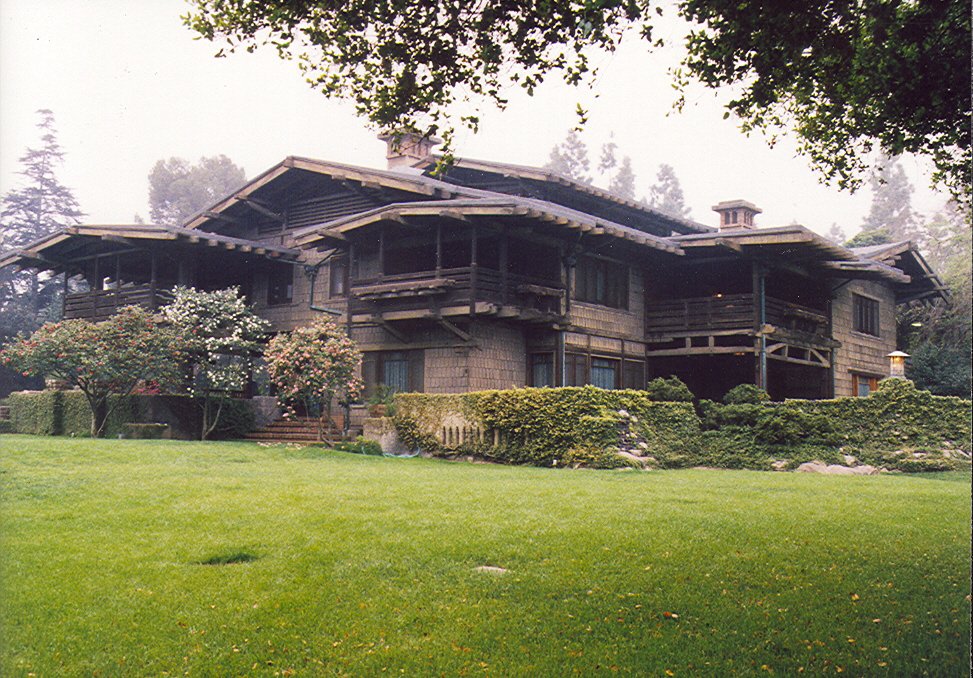On the heels of the Victorian came the Craftsman Style, with its reverence for all things handmade. The Craftsman period is better thought of as a rejection of the societal damage and disruptions caused by the industrial revolution. The movement emphasized natural materials and basic forms, tossing aside excessive ornamentation, and elevating human creation and the natural over the mass-manufactured.
Photo credit: C.C. Pierce & Co.
Many historians argue that the Craftsman period is one of the early modern movements, stripping away ornamentation, emphasizing function, reducing the dwelling to its basic form, and consequently reducing costs. Designers in this period favored a return to traditional crafts that were hewn, carved, or otherwise made by a human. The movement emphasized the handmade in ceramics, leaded glass, furniture, metalwork, printing and the like, elevating the worker from a dehumanized cog in an industrial setting to one with a dignified and moral purpose.
Whereas the European Arts & Crafts movement was focused on objects, the American version prioritized architecture and dwellings. Therefore, the American Craftsman movement can be considered a movement in housing accessibility, since this less-ornamented style allowed for cheaper home production.
The Craftsman architectural movement began primarily with the work of the two Greene brothers, in Pasadena, California. Their designs, while conscious of the ideals of the continental Arts & Crafts movement, were uniquely American, drawing inspiration from the simple ergonomic designs of the Shaker communities, as well as Asian influences on the West Coast.
Photo credit: Kwak2
The Greenes experimented with and formulated a simple style, which they called the “bungalow”. The bungalow had a lower sloped roof, as opposed to the steep Victorian pitches. Turrets, towers and other extraneous features were eschewed as gaudy faux historicism. Heavy eaves emphasized the purpose of a home as a shelter from the elements, while clean lines and uncluttered exteriors featured wood shingle siding. Gone was the riot of fish scale patterns and other styles and bric-a-brac now considered nothing but excessive ornamentation. Simplicity was the name of the game.
These cost-effective designs were replicated in magazines and pattern books, and available in kits so easily replicated, that they soon became the most common and fashionable smaller homes in the country. The Greenes made higher-end interpretations of the Craftsman style, featuring structural wood beams as expressed ornamentation, but the central thesis of these structures, with their masses of organic or natural materials, remained the clear link to the environment.
Photo credit: Internet Archive Book Images
Unlike the European Arts & Crafts movement, the American Craftsman movement emphasized simplicity as a means to increase access to design. Homes with less ornamentation were more affordable. Furniture designed with elegant simplicity, such as Gustav Stickley’s iconic oak pieces, was easier to produce and filled many elegant middle-class living and dining rooms.
The color palette of a Craftsman home remained one of rich and deep tones, similar to the Victorian period. However, where Victorian homes featured wallpaper and decorative ornament, Craftsman homes were painted in solid, deep, rich colors, but with less patterning. Exteriors were often one color, green or brown, again echoing the natural world in an attempt to blend into the landscape, rather than stand out from it. Interiors featured wood paneling and stained millwork (not painted!), foregrounding the natural beauty of the material.
Craftsman homes benefited from numerous technological innovations, such as central clean-burning gas heating, electricity and electric lighting, and of course reliable indoor plumbing and the rise of multiple bathrooms. Another influence on this period of design was the Spanish Flu influenza pandemic of 1918, which killed about one third of the global population. As public life ground to a halt, with schools cancelled and church meetings suspended, home design was affected as well. Cleanliness and health became of critical import. Bathrooms and kitchens were now designed with tile finishes so that the surfaces could be wiped down and sanitized, and the rooms themselves were in fact referred to in the literature of the time as “laboratories”. Since it was desired that all surfaces be scrubbed, water-soluble interior wall paint was used. Exterior sleeping porches and even open-air influenza rooms became another common feature of the era.
The Craftsman style period is inescapably linked with the social reforms of the period and the global upheavals caused by disease. Although the period benefited from the tools developed during the industrial revolution, such as milling and other forms of production, the emphasis on simplicity meant lower costs and a further democratization of residential design and construction. More single-family homes meant more independence and control over one’s destiny. Unlike the Victorian period, with its emphasis on excess, the Craftsman focus on simplicity and the humanity of craftsmanship reflected the progressive reforms and social activism of this period: the fight to improve worker conditions, eliminate exploitation of labor, and alleviate poverty.
Stay connected and never miss out! Subscribe to our newsletter for exclusive access to upcoming events. a collection of magazine articles, and blogs.




